What is a Sea Shell?
Seashells are primarily composed of calcium carbonate or chitin and usually come from marine invertebrates. They can be found washed up on beaches. Often, these shells will be empty because the animal has died and its soft parts have decomposed or been eaten by another animal.
Some common examples of seashells include those from mollusks, barnacles, horseshoe crabs, brachiopods, sea urchins, and molted shells from crabs and lobsters. There are also internal shells belonging to some cephalopods.
Seashells have a long history of being used for various purposes by humans in both prehistory and modern times. Aside from seashells, many different kinds of shells are found in freshwater habitats, such as mussels and freshwater snails, as well as land snails.
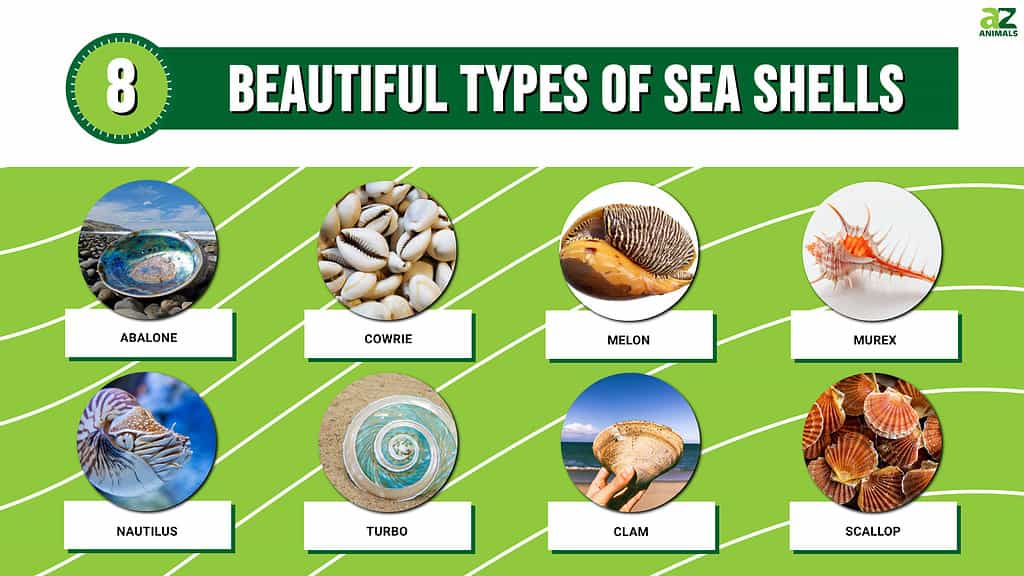
How Are Seashells Made?
The shell creation process begins with the mantle, an outside layer of tissues connecting the mollusk to its shell. Specialized cells within this mantle form and secrete the proteins and minerals necessary for constructing a protective covering. The proteins help create a framework upon which the rest of the shell can grow. At the same time, calcium carbonate aids in adhesion between layers by providing strength and rigidity to the structure as it grows.
It takes weeks or months for these components to come together into one cohesive unit. When the shell is complete, it provides essential protection from predators, parasites, and environmental stressors such as temperature changes or pollution. After its formation, certain species may also use their shells to camouflage themselves in different habitats by altering their coloration or shape.
How Many Types of Shells Are There?
There are between 70,000 to 120,000 species that live in a shell. Here we will highlight eight beautiful sea shells that you can find on your local beach.
1. Abalone Shell
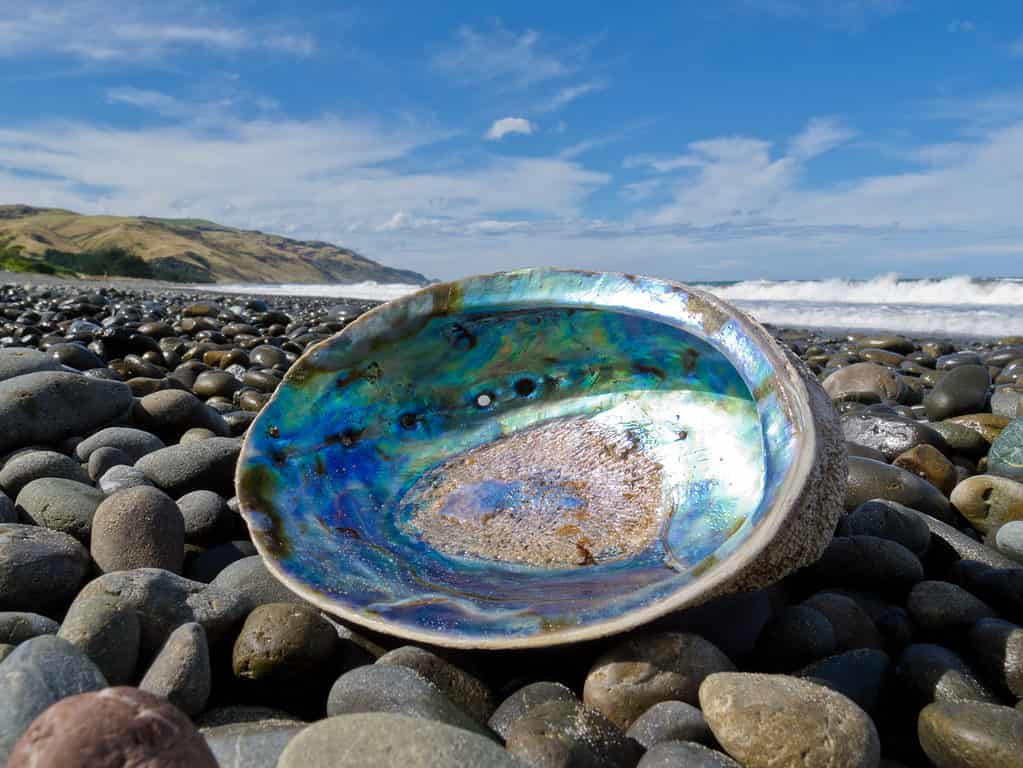
All abalones have natural holes that run along one side, which allow them to draw in seawater for breathing purposes.
©Pi-Lens/Shutterstock.com
Abalone shells are often seen as a beautiful addition to any home decor. They are used in various ways, such as dishware, jewelry pieces, and buttons. The spiral whorl of the shell is one of its defining features that makes it unique from other shells.
All abalones have natural holes that run along one side, which allow them to draw in seawater for breathing purposes. These mollusks attach themselves to rocks with their large muscular foot, which is also edible and highly esteemed. Creative minds can use these shells for projects; they make lovely knife handle embellishments or even inlay designs on furniture or art pieces. Abalone shells are also used for spiritual practices like smudging rituals.
Common types of abalone shells include green abalone, red abalone, pearl abalone, white abalone, cream abalone, and Paua abalone.
2. Cowrie Shell

Cowries have an oval shape that is glossy and smooth to the touch but lined with tiny teeth around both lips of their opening.
©Klaus Vartzbed/Shutterstock.com
Cowrie shells are some of the most beautiful and unique seashells on the planet. They come in around 200 different varieties, with each one boasting its own unique colors, patterns, and textures. These shells are native to warm coastal waters, where they can be found glimmering in sand beds or among coral reefs.
Cowries have an oval shape that is glossy and smooth to the touch but lined with tiny teeth around both lips of their opening. Although cowries were once used as currency by people living near these coastal areas, today, they are mainly appreciated for their beauty alone. People enjoy using them as jewelry, charms, or collectibles – sometimes called “sailors valentines” – or even incorporating them into craft projects. However you choose to use them, it’s hard not to be captivated by these amazing sea creatures’ vibrant colors and intricate patterns!
Common types of cowrie shells include tiger cowrie, deer cowrie, money cowrie, purple top cowrie, and egg cowrie.
3. Melon Shell

Melon shells belong to the genus of volutes but differ slightly.
©Meshutt/Shutterstock.com
Melon shells or volutes are attractive sea shells with distinctive markings and a wide aperture. The name voluta in Latin translates to “forming a spiral curve or curves.” These colorful shells have an inner lip with three or four plaits (grooves, teeth, or folds). They also feature an initial bulbous whorl at the apex of the shell, which looks like a shiny nub.
You can find volute shells on coral sandy or muddy bottoms, mainly in deep waters of tropical seas, and they are all carnivorous. Melon shells belong to the genus of volutes but differ slightly. They are rounder and fatter giving them their melon shape. These sea creatures got their nickname “bailer shells” from their ability to hold large amounts of water, making them useful for bailing out boats if needed.
Common types of melon shells include imperial volute, noble volute, volute lapponica, and Philippine melon.
4. Murex Shell
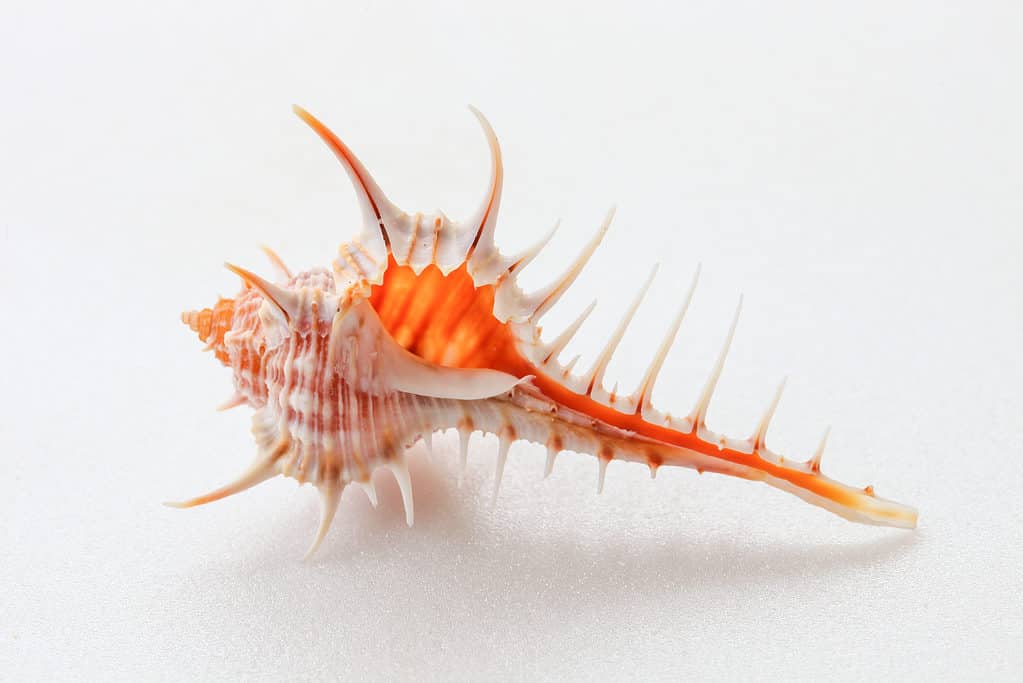
While some Murex shells are brightly colored and vibrant, the majority tend to be more muted in color.
©Akira II/Shutterstock.com
Murex seashells are renowned for their incredible range of ornamentation and sculpture. From intricate frondose spines to webbed wings, lacy frills, and knobby whorls, these shells have much to offer collectors. While some Murex shells are brightly colored and vibrant, the majority tend to be more muted in color. Yet, they still possess an undeniable beauty that makes them highly sought-after items for collectors worldwide.
These mollusks inhabit a wide variety of habitats across the world’s oceans – from tropical regions all the way up near polar regions – where they feed on other mollusk species, such as bivalves. They can often be found living on muddy sand flats, where they easily blend into their environment.
Common types of murex shells include murex ramosus, pink murex, endiva spine murex, and virgin murex.
5. Nautilus Shell
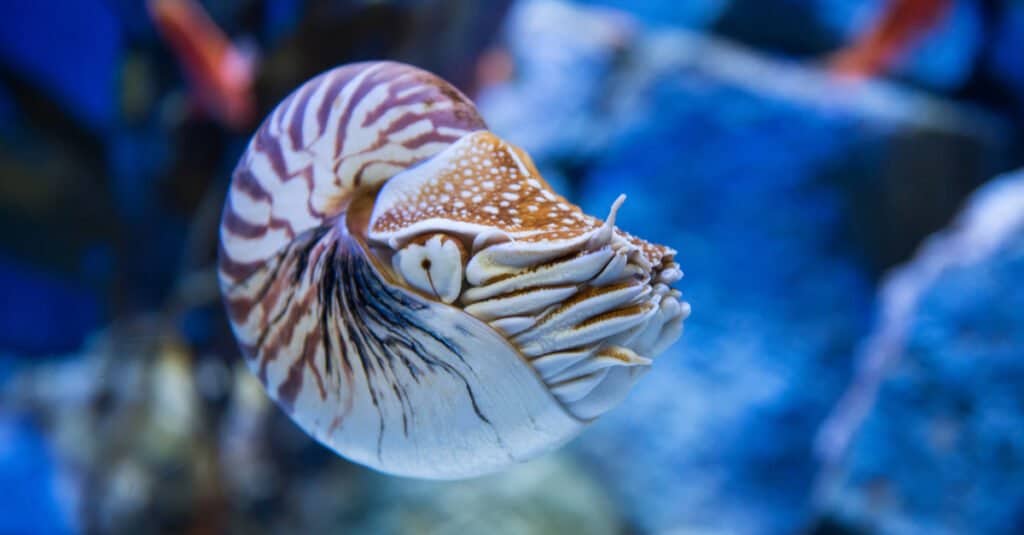
Chambered nautiluses have been found worldwide but are most commonly seen in the central Philippines.
©kikujungboy CC/Shutterstock.com
Nautilus is unique among Cephalopods, with their external spiral shell. This remarkable structure is composed of many chambers and is perfectly proportioned mathematically, a testament to natural engineering. The air in these chambers helps them control buoyancy as they hunt for prey, such as lobsters, crabs, hermit crabs, and other creatures on the sea floor.
Chambered nautiluses have been found worldwide but are most commonly seen in the central Philippines, where fishermen set traps baited with chicken to catch them for food. These mollusks have been traced back 500 million years, making them one of the oldest living species today, earning them the title “living fossils.”
Common types of nautilus shells are natural nautilus, pearl nautilus, and center-cut nautilus.
6. Turbo Shells
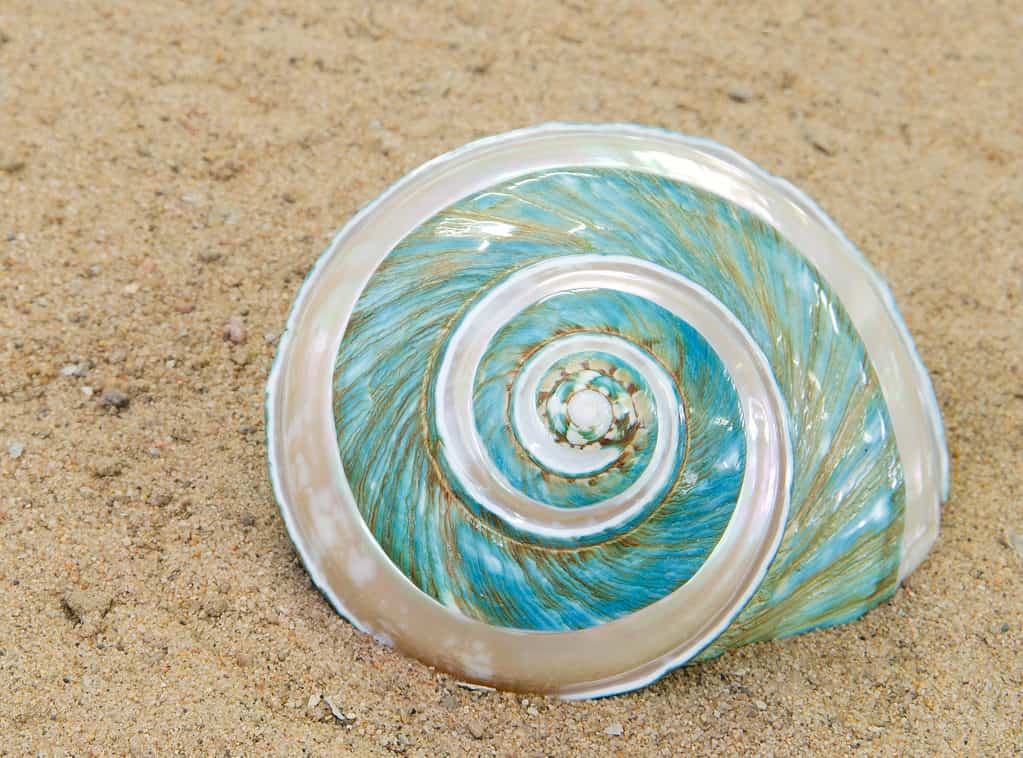
Turbo shells tend to be quite durable but can break if handled too roughly or exposed to extreme temperatures for extended periods.
©Lost Mountain Studio/Shutterstock.com
Turbos, also known as turbans, are top-shaped shells with a wide opening and pointed apex. They belong to the large family of Turbinidae, which consists of several hundred species found mainly in tropical seas. These mollusks are vegetarians that feed primarily on marine algae.
The shells range from smooth to spiny depending on the type and may be brightly colored or muted tones such as browns, whites, and grays. They tend to be quite durable but can break if handled too roughly or exposed to extreme temperatures for extended periods. In addition, some species have been known to live up to 40 years in their natural environment, making them an ideal shell for collectors looking for something rare or unique!
Common types of turbo shells are pearl banded jade turbo, green jade turbo, polished silver mouth, and spotted turbo.
7. Clam Shells
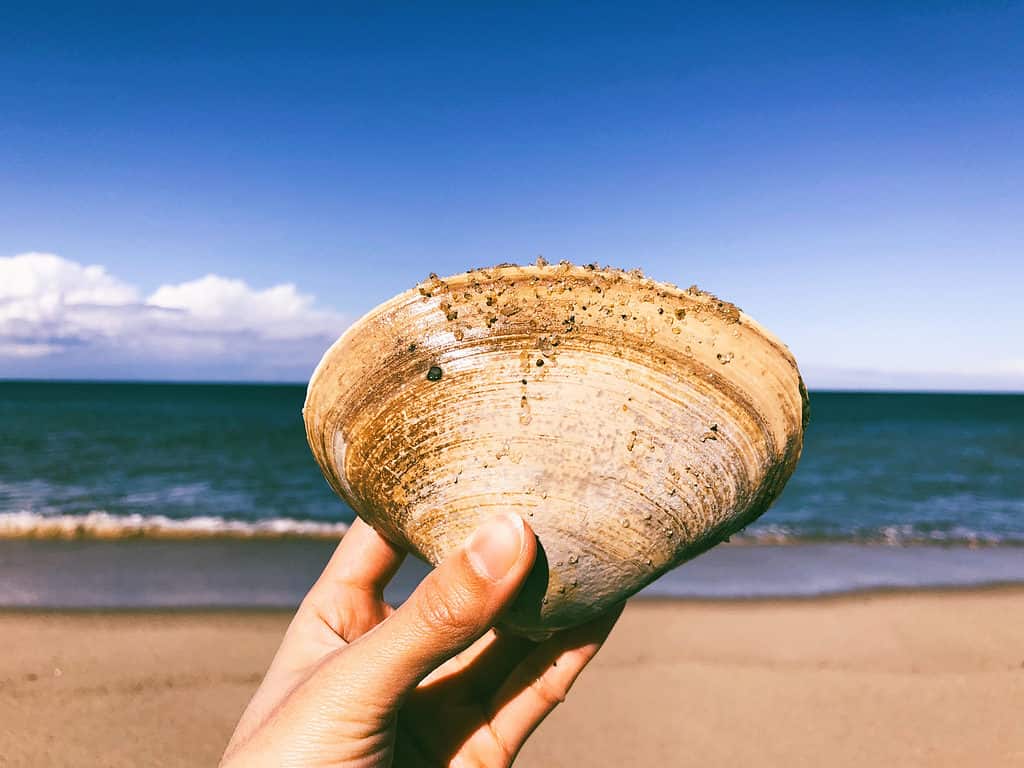
Clamshells are found along beaches and coastlines, making them easily accessible for many people.
©Shanshan0312/Shutterstock.com
Clams are a type of mollusk found in the ocean and have two shells that open and close. They differ from other bivalves because they bury themselves in sediment rather than attaching to a substrate like scallops, oysters, or mussels do. Clams can be eaten raw, steamed, boiled, baked, fried, or made into chowder.
Clamshells are found along beaches and coastlines, making them easily accessible for many people. Their beautiful and unique shapes make them popular as decorative pieces in homes or offices. Collectors may also find themselves drawn to clam shells due to their range of sizes, colors, and patterns, which can lead to interesting displays when put together.
Clamshells also have a long history associated with them; indigenous cultures traditionally used them for tools such as jewelry, weapons, utensils, and more. As such, they are not just visually pleasing but symbolically meaningful too!
Common types of clam shells are whole pearl clam, bear paw clam, Cardium heart, jumbo ark, and heavy cockle.
8. Scallop Shells
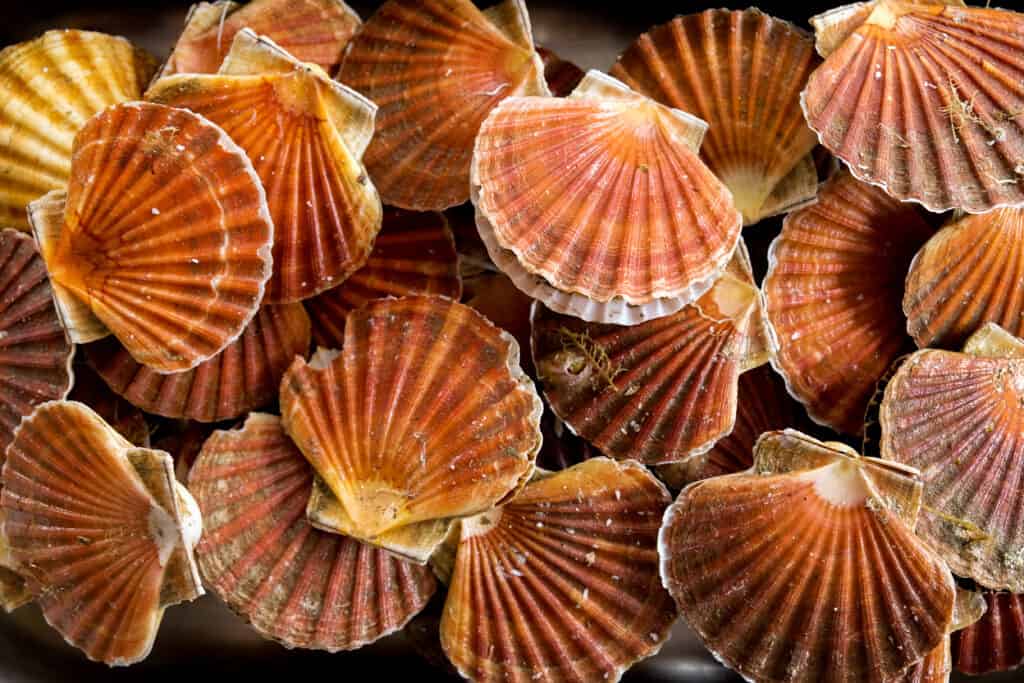
Scallop shells are bivalve mollusks with a fan-shaped shell composed of two hinged halves.
©An over head view of twenty scallop shells with scallops inside stacked together in a metal tray/Shutterstock.com
Scallop seashells are a type of marine bivalve mollusk related to oysters and clams. The difference between scallops and other kinds of shellfish is their ability to swim. By opening and closing their shells in rapid succession, they can propel themselves forward in a zigzag direction.
You can find scallops in both tropical and polar waters, but most species thrive in warmer climates. Scallop shells are bivalve mollusks with a fan-shaped shell composed of two hinged halves. The exterior of the scallop shell is typically brown, white, or pink and has radiating ribs along its edge. Scallops usually range in size from two to five inches in width. They can be found living in shallow water habitats all around the world.
Common types of scallop seashells are orange lion’s paw, Irish deep, purple pectin, yellow pectin, and pallium pectin.
What Is the Best Way to Find a Variety of Shells?
Exploring different beaches and tide pools can help you find a wide selection of shells. Bring along some supplies, such as a bucket, net, and gloves, so that you don’t damage any living creatures while collecting your shells.
Is There Anything I Should Know Before Collecting Shells?
When collecting shells, it is important to be aware of any local regulations and ordinances that may be in place. Additionally, many beaches are protected areas where shell collection is prohibited altogether. In some places, the shells you collect must not exceed a certain size or quantity.
Furthermore, the practice of taking live creatures from the beach for souvenirs should never be done – this can damage the local environment by removing species from their habitats and disrupting food chains.
Additionally, when walking on beaches, always stay on designated paths and do not disturb wildlife or vegetation; follow all posted signs regarding access restrictions, as well as respect private property boundaries if applicable. Taking only dead shells that have been naturally separated from their original habitats will help ensure that no harm is caused to living organisms or environments during your collection activities.
Is Anybody Home?
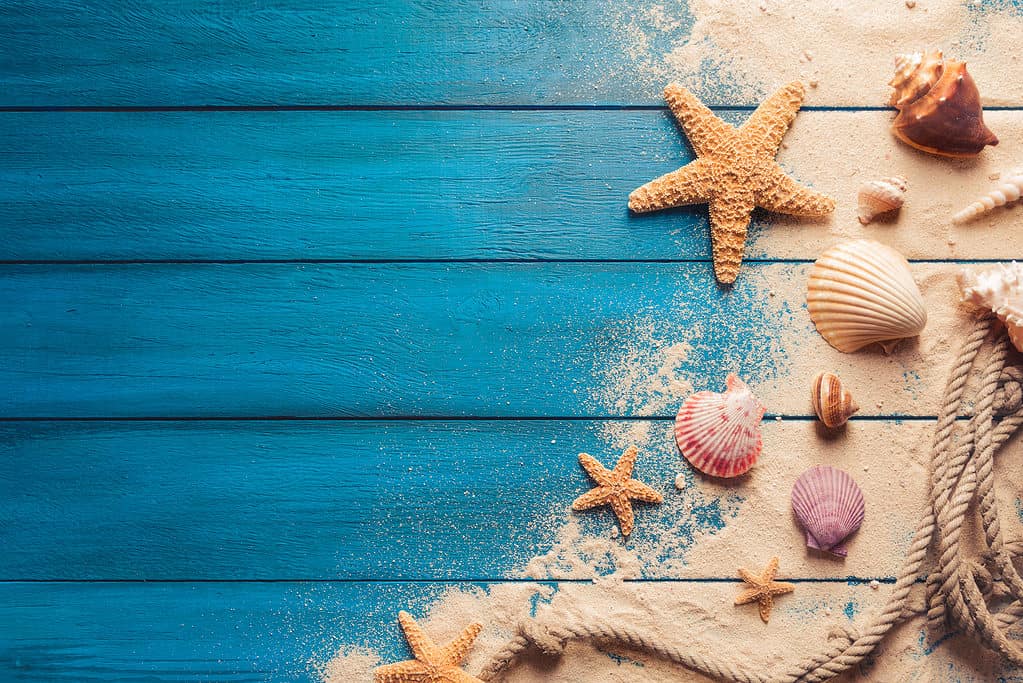
Aside from seashells, many different kinds of shells are found in freshwater habitats, such as mussels and freshwater snails, as well as land snails.
©Fer Gregory/Shutterstock.com
When you pick up a shell, it may be difficult to tell if the animal that once lived in it is still alive. To determine if this is the case, take the shell and place it either in a container of seawater or in a small tide pool and observe for a few minutes. If all goes well after some time has passed, the animal will begin to extend out of its hiding spot inside the shell as it starts to explore its new surroundings. This is your cue that they are indeed still alive! At this point, quickly release them back into their natural habitat exactly where you found them so they can continue living without disruption from humans.
What is The Best Time to Collect Shells?
Low tides are the perfect time to collect shells as the shoreline is exposed and more of the ocean floor is revealed. During this time, you can find different types and sizes of shells on beaches or in shallow waters. It’s best to look for shells during low tide as the high tide will bring back most of the water, washing away any potentially great finds you may have encountered. Check online sources like tidal charts or websites with real-time information about local tide times to find out when low tide occurs. Alternatively, you can check your local newspapers or dive shops for printed schedules and other details related to tides in your area.
Can You Hear the Ocean in a Sea Shell?
The noise you hear when you put a shell up to your ear is actually the sound of air passing through and over its surface. This kind of noise is similar to what you might hear if you held any sort of bowl or container close to your ear.
To demonstrate, cup one hand around your ear and pay attention to the sounds that come from it – this is an example of ambient noise in a resonant cavity. The type of sound emitted by shells varies depending on their size, shape, and any contours within them that cause air turbulence as it passes through or over them. In other words, no two shells will produce exactly the same sound since each has its own unique characteristics that influence how much resonance can be created with their particular design.
How Do I Clean a Sea Shell?
It’s easy to care for these shells as long as they are empty. If you find an animal still living inside, dispose of it and wash the shell with soap and water in a bowl. Once cleaned, set them on paper open side down so they can dry without leaving any residue or moisture behind.
To bring out their natural colors, apply a small amount of silicone grease or jelly to your finger, then rub it all around the shell before buffing it off with a soft cloth or towel. Avoid using any acid-based products because this will damage the shell over time. If there is foreign matter stuck to the shells, soak them in a dilute bleach solution until it loosens up and comes off easily. Appreciate nature’s wonderful creations by taking proper care of your sea shells!
Summary of 8 Beautiful Types of Sea Shells
| Type of Sea Shell | Mollusk Family | Habitat |
|---|---|---|
| Abalone | Haliotidae | Cold waters. |
| Cowrie | Cypraeidae | Mostly Indian and Pacific Ocean coastal waters; but widespread. |
| Melon | Volutedae | Coral sands of muddy bottoms of deep tropical waters. |
| Murex | Muricidae | Wide variety of habitats. |
| Nautilus | Nautilidae | Worldwide, but mostly central Philippines. |
| turbo | Turbinidae | Tropical waters. |
| Clam | Veneridae | Beaches, coastlines. |
| Scallop | Pectinidae | Shallow water. |
The photo featured at the top of this post is © Fer Gregory/Shutterstock.com
Sources
- Woods Hole Oceanographic Institution, Available here: https://www.whoi.edu/know-your-ocean/did-you-know/how-are-seashells-made/
- Marine National Park Headquarters, Available here: https://www.marine.gov.tw/ecology-and-conservation/latest-discovery/marine-knowledge/98-Ecological%20Knowledge/614-How%20many%20types%20of%20sea%20shells%20are%20there?
- San Diego Natural History Museum, Available here: https://www.sdnhm.org/science/marine-invertebrates/resources/faqs-on-marine-invertebrates/
- Naples Sea Shell Company, Available here: https://naplesseashellcompany.com/scallop_seashells.html
Thank you for reading! Have some feedback for us? Contact the AZ Animals editorial team.






